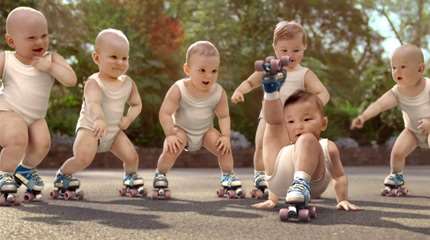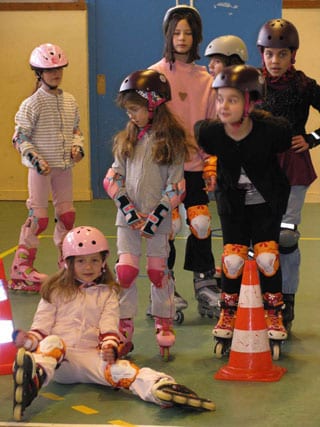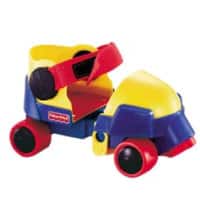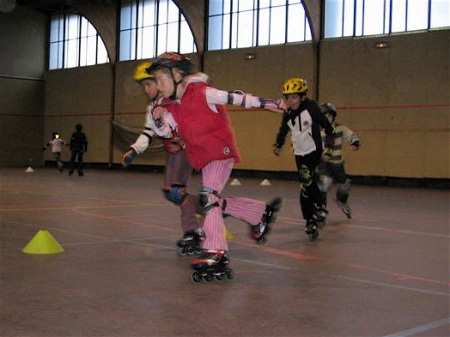Skater kids: From what age?
Many parents want to buy skates to their kids from the earliest age… And all the more when they are skaters themselves. Irremediably, several questions come to people's minds: At what age can a kid start? What type of skates to buy? How to help them improve safely? Answers…
Par alfathor

Several factors should be taken into account
 Very often, the playful aspect of gliding sports and skating attracts kids, as soon as their earliest age. Then, lots of parents buy « Toys’R’Us »-type traditional skates with plastic wheels…
Very often, the playful aspect of gliding sports and skating attracts kids, as soon as their earliest age. Then, lots of parents buy « Toys’R’Us »-type traditional skates with plastic wheels…
Motivity gets more refined with age
During the first years of their lives, kids progressively learn how their bodies and their muscle systems work. First, they acquire a general motivity, then it gets more refined. Their movements become more and more precise, the kids become aware of their postures, of the position of their limbs. This is proprioception (perception of body parts in space).
Generally, kids start walking at around 12-15 months, and walking on uneven grounds at around 21 months.
At nursery school, kids improve their motivity thanks to playful activities. Kids will be all the more skillful as they are regularly confronted with soliciting motor tasks. However, these tasks should be of optimal – not maximal – difficulty, i.e. related to their skill levels.
At what age can a kid start skating?
A noncommittal reply has to be stated. Sometimes some kids may start at 3 or 3 and a half, but some will not be able to practice before the age of 6.
Skating appeals to the ability of keeping your balance a lot, for kids and grown ups. The motor development can end up later for some kids than for some others.
Some 3 1/2 year-old kids won their first races without difficulty, for example Benjamin Pierre-Jean (TUESG) who is now in the French Team of Speed Skating. He would pass much older kids thanks to a better balance and a better technique.
Most of the Elite skaters who became World Champions in France started at around 6. If you see that your kids lose their balance or have a hard time staying on their feet, do not force them, they will try again later. It is better to let them take their time than to discourage them as soon as their first pushes…
What type of skates to choose?
 Skating is a gliding sport. The obvious is sometimes good to be reminded because lots of parents buy skates with wheels that do not turn or hardly turn, like those Fisher Price models. Is it really a good choice?
Skating is a gliding sport. The obvious is sometimes good to be reminded because lots of parents buy skates with wheels that do not turn or hardly turn, like those Fisher Price models. Is it really a good choice?
Not really, because their poor gliding will force the kid to push to move forward. And as the wheels « jam », the kid is going to copy the movement of walking. All in all, the push will not be good and the kid will acquire a bad skating technique.
The solution consists in buying « real » skates even if it means using very greasy bearings with a low ABEC norm. The grease will slow down the rotation of the wheel but it will not jam. So that if the kid copies the movement of walking, the wheel will not put up much resistance and the kid will have to adapt the movement to go forward.
Real skates are a bit more expansive but they will be a real motor challenge for the kid who will learn to skate properly from the very start. With a low range product, if used for too long, there will be a phase of ‘unlearning’ of the wrong movement before mastering the good technique.
One-size or adjustable skates?
One-size skates, like skates for grown-ups, perfectly suit to the practice of skating but you will have to change more often, all the more as kids’ feet grow fast! If they are cheaper (around 30€), they will have to be changed more often. If the kid uses them regularly, it is not much of a problem because skates are put to a severe test…
Another solution consists in investing directly into adjustable kid skates. Most of the big brands on the market have 4-size adjustable skates today, for example: from 29 to 32, 33 to 36, 37 to 40.
The initial investment is bigger (around 80€) but in the end you are a guaranteed winner… all the more as these skates are easy to resell on second-hand markets.
How to make your kid improve safely?
 There is no age to practice safely! Never forget to equip your kid with the whole protective pack:
There is no age to practice safely! Never forget to equip your kid with the whole protective pack:
- elbow pads
- knee pads
- wrist guards
- and helmet obviously!
If good habits are acquired early, they become natural in the end!
Why learning skating early?
Just like for lots of sports, the earlier you learn the quicker and the more instinctively you acquire skills.
And this, thanks to several factors:
- kids have less apprehension than grown ups
- kids learn faster
- kids are curious and want to discover new activities
Moreover, kids’ skeletons are still flexible and bear shocks and falls better.
How often to practice?
A regular practice favors learning, as the kid is going to reinforce the knowledge and improve. Once a week is a good start, two to three times a week enable to reinforce the acquired skills.
Note: Do not force the kid to practice. Skating, just like the other sports, should be practiced for pleasure with no obligation.
Moreover, the younger the kid, the less focused. Do not be surprised if the kid gets bored after fifteen minutes on wheels, move on to something else. To another skating activity, another game on wheels, or another physical or intellectual activity.
All in all, avoid persistence. Vary activities and above all, try to teach with games (it also works with grown ups).
Useful links
What type of roller-skates will suits you ?
Translation: Chloé Seyres
Photos : Roller34, rollerenligne.com, all rights reserved
